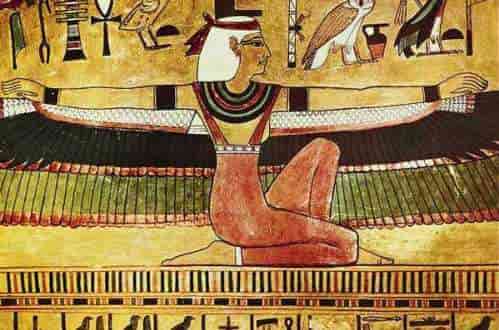Isis is one of the main deities of the Egyptian pantheon. She is the mother goddess, associated with fertility and motherhood, and therefore the center of many cults related to life. Actually, by calling her Isis we are calling her by her Greek name, since the ancient Egyptians knew her as Aset.
Aset can be translated into English as “throne”, and precisely the hieroglyph that represents the throne was present in the iconography that symbolized Isis. She was generally illustrated as a woman who carried that sign, Aset, on her head.
Goddess Isis was called “Great magician”, “Great mother goddess”, “Queen of the gods”, “Fertilizing force of nature”, “Goddess of motherhood and birth”.
Goddess Isis was the daughter of Ra, the wife and sister of Osiris, and the mother of Horus.
Iconography
Goddess Isis can also be seen in different inscriptions as a seated woman, crowned with the solar disk ; shaped like a tree, suckling the pharaoh; and frequently with kite wings, opening her arms to bless her devotees and children.
In her anthropomorphic version, Isis was represented as a woman wearing a tight dress, crowned with the “throne” previously described.
At the beginning of the 18th dynasty and in the Late Period , she is represented with:
- Horns and a solar disk between them, in the manner of the goddess Hathor, therefore attributes taken from this last goddess.
- Sistrum and menat , symbols of the goddess Hathor.
- Ankh and papyrus scepter that she usually carries in her hands.
- Headdress in the shape of a vulture, attribute of the celestial goddesses. Before being shown with this vulture headdress, she wore a crown in the shape of a royal throne.
- Tyet (knot of Isis), a symbol of protection and fertility.

The Story of Osiris and Isis
In the Heliopolitan cosmogony her parents were Geb and Nut. She was most prominent mythologically as the wife and sister of Osiris and the mother of Horus and was revered as the archetypal wife and mother. Plutarch wrote a story telling her story:
Osiris, brother and husband of Isis, reigned in ancient Egypt with peace, harmony and wisdom. The Nile fertilized the land and the crops were abundant. His subjects were happy.
One day, Osiris went on a trip and left the kingdom under the command of his wife Isis. Seth , his envious brother, felt humiliated because he believed that he should rule and not Isis.
When the god Osiris returned, Seth wanted to have a great welcome party and launched a challenge to the guests: whoever entered the chest that Seth had brought, he would give it as a token of fidelity and respect. Many tried but the coffer was small or large.
Osiris, curious, wanted to try and fit perfectly well. Seth knew the size of the brother and that was why the chest had served him like a glove. Immediately the brother, together with 72 accomplices, closed the metal box hermetically and threw it into the Nile.
Isis, with love and trust, began her journey to recover her husband’s body. After long and painful walks through Egypt, the goddess finds the chest with the remains of Osiris.
But the drama continues when Seth, in his endless wickedness, stole the corpse and cut it into fourteen pieces which, again, he scattered throughout the kingdom.
Isis does not give up and, in the company of her sister Nephthys, Seth’s wife, goes through every part of the kingdom. They finally manage to find all the pieces other than the penis.
However, Isis rebuilt Osiris aided by Anubis and Nephthys, and impregnated with him she conceived a child Horus ( Harpocrates ), who would later avenge his father by fighting Seth.
Epithets of Isis
Some of the epithets that the goddess received are:
“Great magician”, “Great mother goddess”, “Queen of the gods”, “Fertilizing force of nature”, “Goddess of motherhood and birth”, “The Great Lady “,” Mother Goddess “,” Lady of Heaven, Earth and Underworld “(in Philae),” Isis in all her manifestations “,” Lady of Raanefer “,” Queen of Mesen “,” Lady of Hebet ” , “Lady of Abaton”, “Lady of the southern countries”, “Lady of the pyramids” in Giza , “the divine, the only one, the greatest among the gods and goddesses, the queen of all the gods”, “the Eye of Ra , the crown of Ra-Heru, Sept”, ” New Year’s Lady “, etc.
Names associated with Isis
Isidore , whose Greek etymology Isis doron, means “gift or gift of Isis”. The name, common in Roman times, survived the suppression of the cult of Isis and is still popular today. Among others, her name is found in various Christian saints.
Isidro , variant of Isidore.
Goddess Isis: Priesthood
Little information has survived on the Egyptian rituals of Isis. However, it is clear that both priests and priestesses were initiates, who officiated the rituals of their cult throughout time.
In Greco-Roman times, many of them were healers, and many others were said to have special powers, including the interpretation of dreams and the ability to control the weather, by braiding their hair or by not combing their hair. The latter was thought, because the ancient Egyptians considered knots to have magical powers.
The Isis cult was believed to have originated in the Nile Delta , around the 5th Dynasty. The oldest inscriptions date from that time, although it gained great importance years centuries later, through association with the worship of other female fertility goddesses.
Her main temple was built on the island of Philae, although today only a few ruins remain.






